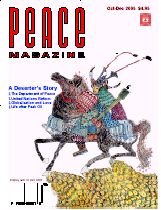
Peace Magazine Oct-Dec 2005, page 28. Some rights reserved.
Search for other articles by Anne Goodman here
Johan Galtung. Boulder, Colorado: Paradigm Publishers, 2005
What do you get when you put together a Cartesian coordinate system with two axes and five points; several fundamental concepts of peace; insights gained from many years of experience; and vivid, often first-hand descriptions of 40 real-life conflicts? Answer: Transcend and Transform, the new book by Johan Galtung.
Transcend and Transform is a short and very accessible book intended as "an introduction to conflict work," to quote the subtitle, and it does this on both a theoretical and a practical level. Based on the philosophy and approach of TRANSCEND, the international peace and development organization co-founded by the author, the book models a week-long on-site training course of a type offered by TRANSCEND. The chapters are named for the days of the week and each takes the reader through a typical training session.
A brief introduction lays out the theoretical ground for the book and provides the reader with vital concepts such as basic needs, violence, and conflict. The TRANSCEND method, based on the aforementioned Cartesian axes and five points, is introduced early in the book. In a nutshell, the method is a search for the points of positive transcendence of a conflict, the both/ and points where the needs of both parties to the conflict can be met in imaginative and creative ways. This is very different from the usual methods of conflict resolution and negotiation, which usually result in one or other of the parties to a conflict prevailing in a win/lose scenario or reaching an often unsustainable compromise in which both sides must give up something important.
This TRANSCEND method is used in the series of real case studies of conflicts that inform the first four chapters. The conflicts range in level and complexity from those between or even within individuals (the micro) to those between civilizations and worldviews (the mega) and everything in between. Beginning with the kinds of conflicts everyone is familiar with, readers learn how to put theories of peace and conflict into practice. They also come to understand that no matter how large or small, a conflict is a conflict, with the same basic elements and principles, and can be tackled in the same basic ways. Referring to these concrete examples, the book also explores what good and bad conflict work looks like, as well as the values and attitudes that are helpful in conflict transformation, such as creativity, empathy, imagination, and nonviolence. Dialogue and negotiation as approaches to conflict are investigated, and readers are shown how important it is to become conscious of the deep texts -- the culture, behaviors, and structures that lie beneath the surface and are taken for granted. I also found intriguing the reflexive use of the TRANSCEND method as critical self-reflective analysis, thus helping conflict workers to avoid some of the blind spots and hubris that can hamper their work.
Written in a dialogical style that reflects the philosophy and methods it describes, the book encourages exploration of ideas and solutions to conflicts without requiring agreement. Galtung invites readers to reflect on each conflict case study as it is formulated and think about what they would have done. Better yet, he suggests, is that people form study groups to talk about the ideas, and thus experience first-hand the transformative potential of dialogue.
Transcend and Transform, then, has much utility as a training manual, but it goes far beyond. Written in an accessible style that is interesting, intriguing and even fun to read, the book does a remarkable job of linking theory and practice, and offers clear and thought-provoking insights.
I found it an exciting, hopeful, and very human book. It shows that things do not have to be the way they are -- that we already have the skills, values, and attitudes for good conflict work, drawn more from life experience than book learning, and that they can adapt to various levels of conflict. We need to become more conscious of what can be done to transform conflicts sustainably, and stop giving a monopoly of conflict work and peace negotiations to the wrong people.
Reviewed by Anne Goodman, a Toronto-based conflict worker.

Peace Magazine Oct-Dec 2005, page 28. Some rights reserved.
Search for other articles by Anne Goodman here